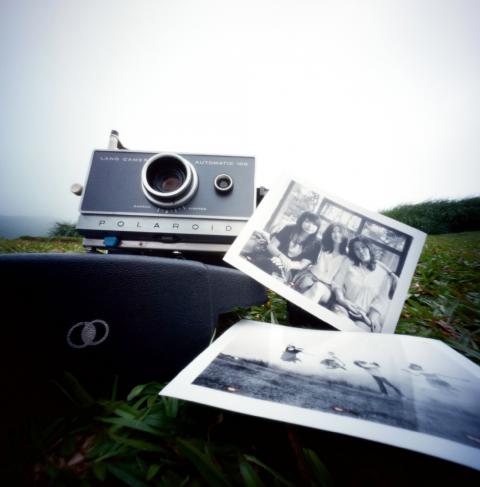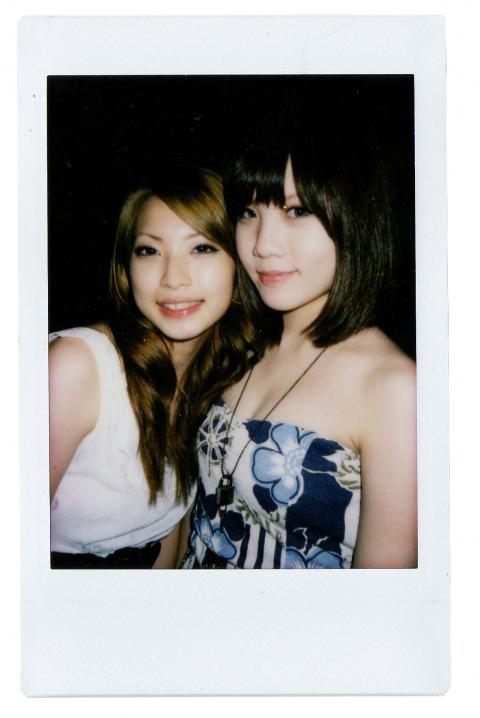When Polaroid Corporation announced that it would stop selling analog instant film products in 2008, fans all over the world went into a paroxysm of grief. “The digital world is cold, colorless, devoid of a soul in comparison,” one wrote on the New York Times Web site.
Over the following three years, however, instant film has enjoyed a resurgence in popularity. The Impossible Project bought Polaroid’s manufacturing equipment and has been creating film compatible with cameras once made by the company. Fujifilm’s Instax instant film products also have their own loyal fan base. (Cameras being marketed as Polaroid 300 in the US and UK are actually re-branded Fuji Instax Mini 7S’s.)
Anyone with access to a smart phone or online editing software can apply “vintage” effects and a white frame to digital photos, but enthusiasts say the appeal of instant film is that it represents photography pared down to its simplest elements.

Photo courtesy of Keryy Lu
“It is the most basic idea of how a photo is made,” says Jun Akaike, the director of Impossible Project Tokyo. “You can smell the chemicals in the pod and hold the film in your hand as it develops.”
After Polaroid stopped producing instant film products in 2008, its equipment was purchased by Austrian entrepreneur and The Impossible Project founder Florian Kaps. His new company faced a giant obstacle, however: the chemical components used in Polaroid’s instant film were no longer available and had to be reformulated from scratch. After working with technicians and engineers who had once been employed by Polaroid, The Impossible Project began releasing its own film in 2010.
At about NT$700 to NT$900 for a cartridge with 10 exposures, The Impossible Project’s products are much more expensive than instant film made by Fujifilm. Akaike says that the high price is due to the low quantities currently produced by The Impossible Project — in 2011, the company manufactured just 100,000 units of film.

Photo courtesy of Tokyomasamune
Pricing isn’t the only issue that users have encountered. The Impossible Project’s current film lines, which include black-and-white and color film, are all extremely sensitive to light and must be covered as they develop, so photographers cannot experience the magic of watching an image slowly appear. Other problems have included photos that quickly fade and so-called “sticky packs,” which resulted from cartridge springs that were too weak to accommodate The Impossible Project’s thicker film.
Akaike says that listening to customer feedback and remedying issues before each new batch of film is manufactured is a top priority for The Impossible Project.
Though currently much less user-friendly than film manufactured by Polaroid, The Impossible Project’s products have cultivated a base of steadfast supporters. Many remain attached to their original Polaroid cameras, which are not compatible with Fujifilm Instax products.

Photo courtesy of Lia Saile G
Interior designer Kerry Lu (陸瑋妗) says several of her friends first became interested in instant film photography after purchasing vintage Polaroid cameras to display in their homes.
“The cameras themselves are gorgeous and a lot of people collect them just to look at them, but many of the cameras are still in working order,” says Lu. “When you press the button and hear the shutter snap and see your photo slide out, it’s very exciting.”
Jerry Lin (林俊毓), who works in the electronics industry, first became interested in instant film photography about a decade ago, when Polaroid’s Time Zero film was still available for SX-70 cameras. While developing, Time Zero images could be manipulated by pressing on the film with a blunt instrument, creating visual effects similar to oil paintings. After Time Zero film was discontinued, Lin began shooting with Polaroid’s 600 film.

Photos courtesy of Rommel Pecson
Lin, who always carries an instant film camera with him when he goes on a trip or out with friends, says he “went crazy and bought as many boxes of film as I could find” when Polaroid announced that they would cease manufacturing instant film.
Despite encountering problems with image stability, Lin says he supports The Impossible Project and buys several packs every time the company comes out with a new type of film.
“If they don’t keep operating, we won’t have new film,” says Lin. “Each new batch is an improvement over the last and I trust that their film will continue to get better.”
For photographers who shy away from The Impossible Project’s current high prices, Fuji’s instant film line is a relatively inexpensive and readily available alternative. Vintage Polaroid Land pack film cameras sold from the 1960s to the early 1980s are compatible with Fuji film (see box).
Fuji also produces its own line of Instax instant film products and cameras. Tony Su (蘇宴微) began selling Fuji products in 2005 after his sister returned from a study trip to Japan with Instax cameras for her friends. Located behind Taipei’s Breeze Center (微風廣場), Su’s Tokyomasamune (東京正宗) store specializes in instant camera and films, as well as accessories like albums, stickers and gel pens for decorating photos. His best-selling camera is the chubby Fuji Instax Mini 7S, which produces pictures that are about the size of a name card.
Su says that most of his customers are women in their late teens and 20s who like bringing their instant film cameras to social gatherings.
“If you are at a party with guests who don’t know one another, you can take a photo of someone and give it to them as a gift,” says Su. “Instant photos give people something to share and bond over. Each one is like a handshake.”
SHAKE IT, SHAKE IT LIKE A …
Film from Polaroid, The Impossible Project and Fuji were or are made with different chemicals and, as a result, each brand has its own signature “feel.” Instant film fans say the colors of Fuji Instax film are very accurate, but cooler than Polaroid film, which created images with a warm, dreamlike feeling. As The Impossible Project improves its chemical formulations, its film has begun to recapture that feeling for many users.
* The Impossible Project’s film can be purchased directly from the company at www.the-impossible-project.com, and through auction sites such as eBay, Ruten (露天拍賣) and Yahoo! (雅虎奇摩) Auctions. New users should consider heading over to Nostalgic Future (www.nostalgicfuture.com) near Dihua Street (迪化街), which is co-owned by instant film enthusiast Jeff Chang. Chang only sells The Impossible Project film from batches he has tested himself. The store, which carries vintage house wares and clothing, also sells Polaroid cameras from Chang’s collection. Nostalgic Future is located at 14, Ln 14, Dihua St Sec 1, Taipei City (台北市迪化街一段14巷14號).
The Impossible Project recently came out with its first hardware product, a flash bar compatible with SX-70 single lens reflex instant cameras produced by Polaroid during the 1970s, and plans to introduce its first original camera in September. For more information, visit www.the-impossible-project.com
* Fuji Instax film and cameras are available for reasonable prices at Tokyomasamune. Cameras that take Instax Mini film range from the Instax Mini 7S (about NT$2,300 to NT$2,900) to the more compact Instax Mini 24 (about NT$3,600 to NT$3,900). Tokyomasamune sells boxes of Instax Mini film with white borders for NT$200 each. Accessories include snap-on close up lens and carrying cases.
Fuji also makes Instax Wide film (NT$250 per box at Tokyomasamune), which produces images that are about 10cm by 6cm. Instax Wide film is compatible with the Instax 210 camera, which range from about NT$3,500 to NT$5,000 for a Hello Kitty special edition. Tokyomasamune is located at 14, Alley 7, Ln 346, Bade Rd Sec 2, Taipei City (台北市八德路二段346巷7弄14號), tel: (02) 2777-3036
Fuji’s FP-100c (color), 100b and 3000b (both black and white) film are compatible with vintage Polaroid cameras that take peel-apart pack film. Many users say the color of Fuji’s FP-100c is “colder” than the pack film once manufactured by Polaroid, but all Fuji pack films are praised for their excellent contrast and richness.
* A fan of Polaroid photos since he was a child, Hong Kong-based collector TM Wong (黃定敏) has accumulated 1,070 instant cameras over the last 20 years. Most of them, including models manufactured by Polaroid, Fuji and Kodak, are catalogued on his Web site at polala.hk/my-list/index.html.

The unexpected collapse of the recall campaigns is being viewed through many lenses, most of them skewed and self-absorbed. The international media unsurprisingly focuses on what they perceive as the message that Taiwanese voters were sending in the failure of the mass recall, especially to China, the US and to friendly Western nations. This made some sense prior to early last month. One of the main arguments used by recall campaigners for recalling Chinese Nationalist Party (KMT) lawmakers was that they were too pro-China, and by extension not to be trusted with defending the nation. Also by extension, that argument could be

Aug. 4 to Aug. 10 When Coca-Cola finally pushed its way into Taiwan’s market in 1968, it allegedly vowed to wipe out its major domestic rival Hey Song within five years. But Hey Song, which began as a manual operation in a family cow shed in 1925, had proven its resilience, surviving numerous setbacks — including the loss of autonomy and nearly all its assets due to the Japanese colonial government’s wartime economic policy. By the 1960s, Hey Song had risen to the top of Taiwan’s beverage industry. This success was driven not only by president Chang Wen-chi’s

Last week, on the heels of the recall election that turned out so badly for Taiwan, came the news that US President Donald Trump had blocked the transit of President William Lai (賴清德) through the US on his way to Latin America. A few days later the international media reported that in June a scheduled visit by Minister of National Defense Wellington Koo (顧立雄) for high level meetings was canceled by the US after China’s President Xi Jinping (習近平) asked Trump to curb US engagement with Taiwan during a June phone call. The cancellation of Lai’s transit was a gaudy

The centuries-old fiery Chinese spirit baijiu (白酒), long associated with business dinners, is being reshaped to appeal to younger generations as its makers adapt to changing times. Mostly distilled from sorghum, the clear but pungent liquor contains as much as 60 percent alcohol. It’s the usual choice for toasts of gan bei (乾杯), the Chinese expression for bottoms up, and raucous drinking games. “If you like to drink spirits and you’ve never had baijiu, it’s kind of like eating noodles but you’ve never had spaghetti,” said Jim Boyce, a Canadian writer and wine expert who founded World Baijiu Day a decade